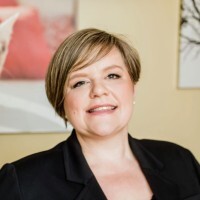Why You Should Care About Retention in Your Veterinary Practice
1. Better Retention = Happier, Hardworking Employees
According to Gallup, companies with low engagement have turnover rates that are 18% to 43% higher than those with high engagement.
Engagement and retention are self-feeding cycle.
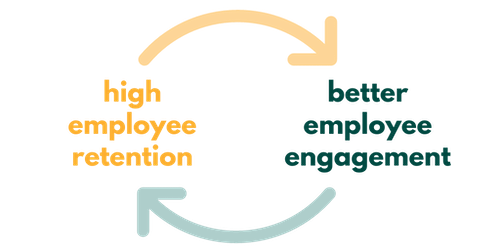
When you have high retention, employees will form greater bonds with their coworkers, leading them to be happier and more engaged in their jobs, leading to continued high retention.
2. Better Retention = Better Client Experience
While there’s plenty of tech tools to help with appointment scheduling, reminders, and patient information management, there’s one thing you’ll never be able to automate in your practice — the actual appointments and the interactions your clients have with your team.
The average business loses up to 20% of customers annually by failing to take care of customer relationships.
That’s a significant chunk of profits when margins are already razor thin in vet med.
So, how do you create better customer relationships?
According to Forrester, companies with highly engaged employees score 81% higher in terms of customer satisfaction than their competitors.
And new data shows that combining employee experience with customer experience can increase revenue by up to 50%.
Cha-ching. 🤑
3. Better Retention = Reduced Costs
Frontiers in Veterinary Science did a study to estimate the economic cost of burnout in the veterinary profession and highlight the financial reasons why the industry should address the burnout crisis from an organizational perspective.
The results? Huge.
If we break it down by position…
For veterinarians, the median industry cost of burnout attributable to turnover is ~ $928 million.
For technicians, the median industry cost of burnout attributable to turnover is ~ $933 million.
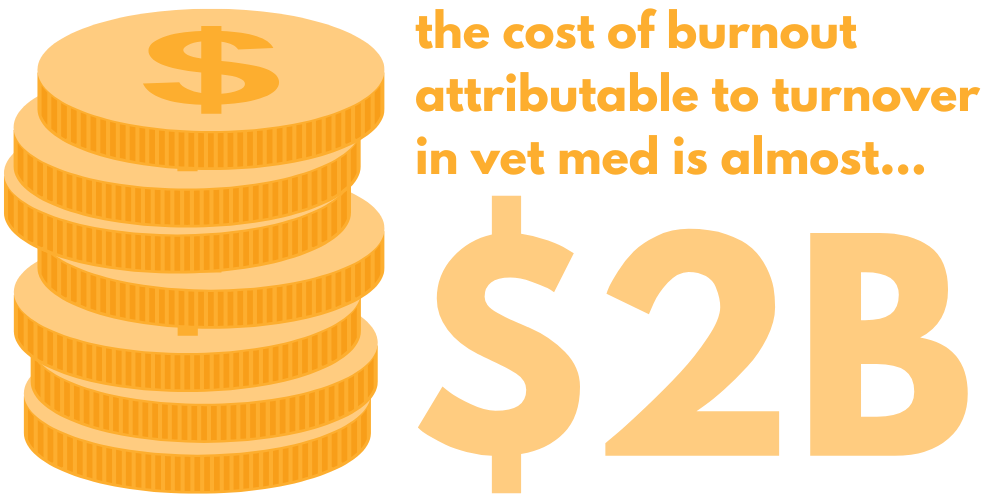
That’s almost $2 billion in costs across the industry just to replace talent.
Those are numbers we can’t afford in vet med.
Let’s bring that down to a practice level.
The Center for American Progress calculates the cost of turnover to be 20% of each employee’s annual salary for workers earning less than $50,000.
For higher paying positions, like veterinarians, they found the cost of turnover could cost as much as twice the amount of the annual salary.
No matter how you slice it, low retention hits your bottom line, hard.
How to Calculate Veterinary Staff Turnover Rate
So now that we know staff retention is highly important, how do we calculate it?
Rebecca Rose, CVT gives us a simple equation to figure this number out.
1. Gather 12 months of employment data
To begin to understand the turnover at your practice, I recommend gathering data from the previous 12-month period. Review your records and determine the total number of separations during the previous year (both voluntary and involuntary, regardless of the reason). Even include the team members who were hired but never showed up, or who were only on staff for a week or two before moving on.
2. Calculate the average # of employees
Next, calculate the average number of employees you would have had in that time. Review your records and determine how many staff members you have had in each position and come up with a general average total staff number.
3. Divide the total # of staff separations by your average # of employees and multiply by 100
For example, if a practice has 30 staff members on average (between a practice manager, veterinarians, veterinary technicians, a receptionist, kennel aids, and groomers) and experienced 10 separations in the past year, then this practice experienced an annual veterinary team turnover of 33%.

What’s a good benchmark for turnover?
According to AAHA’s Compensation & Benefits report, the average yearly veterinary team turnover rate is 23%.
If we break that number down by position:
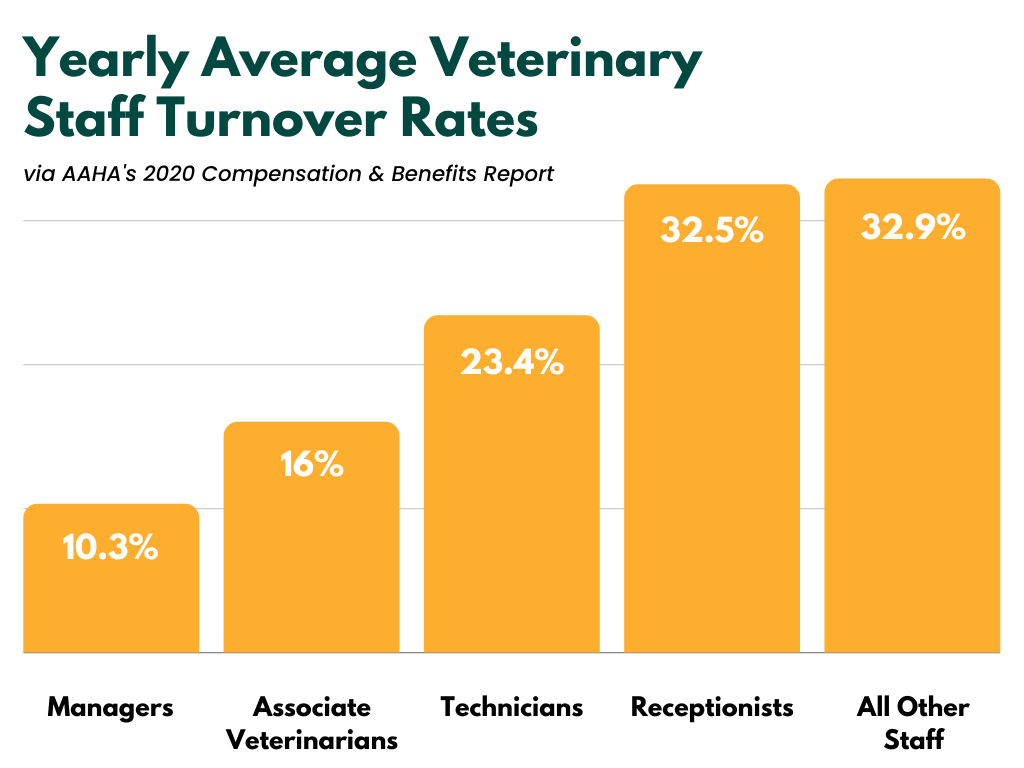
Turnover was 10.3% for managers, 16% for associate veterinarians, 23.4% for veterinary technicians, 32.5% for receptionists, and 32.9% for all other staff.
Were you above or below the average?
If you were above the average, you may have a serious retention problem.
If you were below the average, you likely still have room for improvement.
How to Improve Veterinary Staff Retention
Now let’s get into the nitty gritty.
How do you keep employees happy, healthy, and engaged so they stay with you?
There are three big components to this:
- Compensation
- Togetherness
- Growth
1. Excellent Compensation
At the end of the day, we all work because we need to make money.
Let’s be honest, if we didn’t need the money, we’d all be tanning on a beach somewhere.
We must be paying our employees well in order to retain them.
According to WTW, 40% of employees would leave a job for an opportunity with a 5% pay increase.

So, how can you stay competitive and compensate your people well?
We got the full scoop from 2 excellent leaders in our space.
Nicole McLeod, Head of Talent Acquisition at Small Door which has locations in 3 of the most competitive and highest cost of living areas in the US (NYC, Boston, and DC) and Cody Creelman, CEO at Fen Vet, a young veterinary clinic in Alberta.
What does excellent compensation look like?
Excellent compensation for us at Small Door is more than just a number.
We work with compensation specialists who help us benchmark our wages to ensure that we are remaining competitive and current with the changes in this industry.
The landscape of talent and compensation has changed drastically over time and it is our responsibility to ensure we are staying competitive, but also contributing to the improvement of pay practices amongst our industry peers in vet medicine.
First and foremost, within the veterinary industry, we have to hit a certain level of pay because support staff deserve to be paid better.
But, it's not just the pay, the raises must be relevant, too, in terms of matching the inflation rate and what we're all struggling with outside the clinic, like our bills going up.
How does your team compensate your employees?
We take a competitive, holistic approach with our compensation practices. Our compensation packages include:
- cash compensation
- a profit sharing bonus for all our practice team employees
- equity for veterinarians
- full benefits package
Our medical teams are paid top-of-the-market hourly rates and salaries that have been properly benchmarked. We also ensure equitable pay by staying within our established salary ranges for each role at Small Door. Check out our nurse salary bands here.
Our doctors are not paid on production and instead receive a profit sharing bonus. Removing production encourages our doctors to build a collaborative environment in the hospital while ensuring they can take time off without the pressure of not bringing in revenue.
Fen Vet is one of the higher paying veterinary clinics in our geography and we're also very transparent:
- Technicians starting at $30
- Assistants & Client Care Coordinators starting at $21
In terms of non-wage compensation:
🏝️ Vacation: 3 weeks vacation for everybody, starting day one.
Everyone from the client care coordinator to the veterinarians deserves to have a break and not burn out. I think it's preposterous that a new tech could start in the industry and not get a break for the first year. Like, how fast do we want these people to burn out? That's just not enough.
😷 Sick Days: We have officially 5 days of sick leave, but there's been a lot of times where we've gone above & beyond that.
Certainly, some of that is situational. Dr. Cheryl, one of our veterinarians, got diagnosed with a heart condition and was out for a month, and we paid her for that whole month because it was the right thing to do.
I couldn't imagine the stress that the team would be under if they weren't getting a full paycheck and then coming into the clinic and trying to do this really hard job that is veterinary medicine. If somebody's busting their ass every single day when they're here, then obviously they're gonna get taken care of by the team when they're not here. Is it unlimited sick days? Kind of.
🏥 Health Benefits: We cover 100% of health benefits with no probation period.
We're a small organization, so we try to get the best possible health benefits we can. I think it's a slap in the face for people to be like, “here's your health benefits package, but you have to pay 50%.”
What research do you do to make sure you’re competitive?
Stay curious! We conduct interviews with other veterinary professionals to determine average salaries.
Market research to determine cost of living standards, the cost of labor averages and rate of pay ranges locally in the surrounding areas.
We also work with compensation specialists to provide additional guidance.
My research is:
- Are people coming to Fen Vet?
- Are they applying?
We've got a massive amount of applications, so that speaks for itself.
I just put all of our job ads on our social media now and the post is simply:
- what the job position is
- what the compensation is
- how you apply
There's no other writing or copy around that — and it works. No other vet clinic that I know of just posts what the compensation is.
And, hopefully, it raises the industry standard, too. Hopefully all the assistants and technicians across the board can have a real conversation with their employers and gain better compensation where they’re at.
What kind of benefits do you offer that go above and beyond the typical ones (health, dental, vision)?
For Small Door...
- 401(k) + 4% company match - with no vesting period!
- A healthy annual CE allowance which we encourage our employees to take.
- Annual memberships to OneMedical, Talkspace, Kindbody, and ClassPass.
- Annual memberships to VetGirl for DVMs and credentialed nurses.
- A one month sabbatical for our tenured employees.
- Private coaching for our Veterinarians.
- No non-compete clauses!
For Fen Vet...
Association Dues: That one's pretty industry standard. The veterinarians have always got $3,000 in terms of continuing education. But, we used to just do industry standard for technicians and that pushed technologists to do very cheap, low quality CE. So, we just launched unlimited continuing education for the veterinary technologists, not the veterinarians. I knew it was a barrier to entry, so we did unlimited — that means unlimited for the accommodations, travel, and the association or conference fees.
Scrubs: We provide 5 pairs of fresh FIGS and new shoes for everybody. We want everybody to feel extra special. That one provides a lot of value, like perceived value, right? People feel nice in their clothes. We want them to not feel like they have to start a job and spend a bunch of money to fit in with the team.
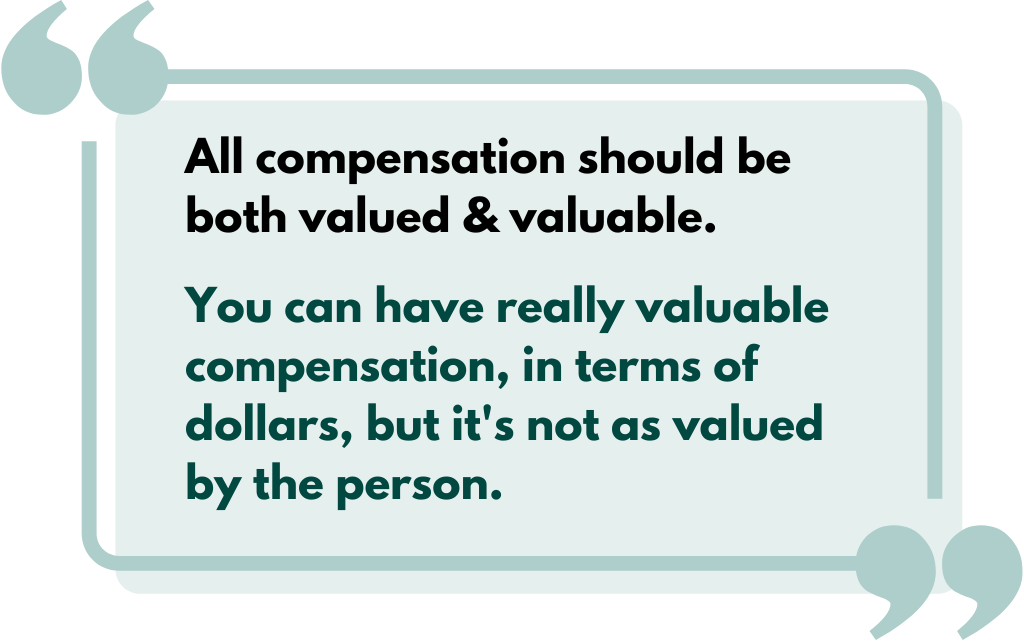
Unicorn Clause: I want all compensation to be both valued and valuable. You can have really valuable compensation, in terms of dollar amount, but it's not as valued by the person.
Then, after a while, some of the benefits just become expected, and that's just human nature. So, I wanted to create something in terms of a benefit that was extra special — the unicorn clause.
With our unicorn clauses, we add them into their offer letters to really fit the offer to the person and make them feel heard & honored as soon as they start.
Examples:
- There's always hot chocolate in the vet clinic, because she doesn’t drink coffee
- She can bring her elderly dog Annie into work
- She has the right to invoke a “bubble tea day” if she think the team needs a pick-me-up and I go get bubble tea for everyone
- She has the first right of refusal on all Frenchie appointments
Like the examples, it doesn't have to be a very valuable clause (buying hot chocolates packets isn’t breaking the bank), but I think it's appreciated that we're trying to be fun & customized to the person.
2. Better Togetherness
Humans are social creatures — we crave connection & recognition.
So, why are our workplaces often so segmented? We put our heads down, get our work done, and clock out.
But, if our employees are just simply going through the motions at work, retention often suffers.
To foster better togetherness and, in turn, better retention, you must focus on 3 aspects of your culture:
- Recognition: how can employees recognize each other for a job well done?
- Reward: how are employees rewarded for a job well done?
- Connection: how do employees connect with each other on a personal level?
To dive deeper into this topic, we teamed up with two awesome teams in the space; Samantha Famous, VP of People at Modern Animal and Ivan Zaks, CEO at Galaxy Vets.
What does team togetherness mean to you?
This can sometimes seem challenging because we have team members spread across vast geographic distances, but we are always thinking about ways to create opportunities for folks to come together in-person or virtually, not only to celebrate our wins, but also to support one another in times of need.
At the clinic level, we provide each of our clinics with a designated quarterly engagement budget for team bonding activities, in-clinic grief counselors, and an extensive employee assistance program.
As an entire company, we have an hour long Town Hall once per quarter that brings everyone on our clinic teams, virtual care team, and office team together for one big meeting where we are able to do a few things:
- provide everyone with visibility into the performance of the business
- highlight members of the team who have best embodied our values over the last quarter
- have an open and inclusive dialogue about some of the challenges the business is facing
How do you bring your team together?
For us, this all comes down to how we instill a shared set of values in our people.
For each of our new hospital openings, we carve out a healthy orientation and training period where members of our team are able to:
- learn about Modern Animal’s mission, vision, and values
- learn about each other’s strengths and communication styles
- learn how to be a trusting, collaborative, and supportive with each other.
Using our values as a compass, we are able to make decisions about what, when, and how we come together with purpose.
One way that this really comes to life for us is our annual company celebration of “Care Team Week” where the whole company locks arms to celebrate our Veterinary Assistants, Veterinary Technicians, and Hosts, who are the collective backbone of our clinic teams.
Through handwritten thank you notes, daily catered lunches, in-clinic massages, special merchandise, and more, our Employee Experience team was able to create a week of memorable moments that brought together and energized people across the whole company.
Galaxy Vets is an employee-owned company which means that every team member has a share in the gains and benefits from our success. We cultivate an owner's mindset where behaviors are guided by shared values and a common purpose.
We use a management methodology called Traction. It builds on the premise that a highly effective and engaged organization is created by putting the right people in the right seats, focusing them on a single vision, enabling systems and processes to achieve this vision, and arming them with metrics to measure success. This approach breaks down silos, facilitates collaboration and alignment, and creates a sense of unity.
How do you empower your team to be their whole selves?
Whether we are encouraging our teams to give candid feedback through monthly surveys and employee councils to celebrating their affinity for tattoos with team tattoo parties, we are building our company on the idea that expressing yourself and your opinions is a fundamental part of what it means to be a Modern Animal.
The key is transparency and open communication. We solicit feedback, not just to track employee satisfaction, but because continuous improvement is one of our core values.
We implemented several mechanisms to do that, and one of them is the Idea Portal. Anyone can submit their idea and it will be reviewed by the dedicated committee.
Once approved, we will help the idea owner take it through a design thinking process, build a business case for it and implement it. The entire team is involved in this process which creates accountability and inspires collaboration.
What do you think is missing from typical veterinary “team bonding?”
We can and should do more than the typical pizza party (nothing against pizza, of course).
A notable example of this idea in action is the “Staff Only” tattoo party that we threw with the help of a local L.A. tattoo shop.
Featuring a night of free veterinary-themed tattoos (real ones), exclusive company swag, signature drinks, and music, the team was able to come together around a common interest and leave with lasting (and for some, permanent) memories.
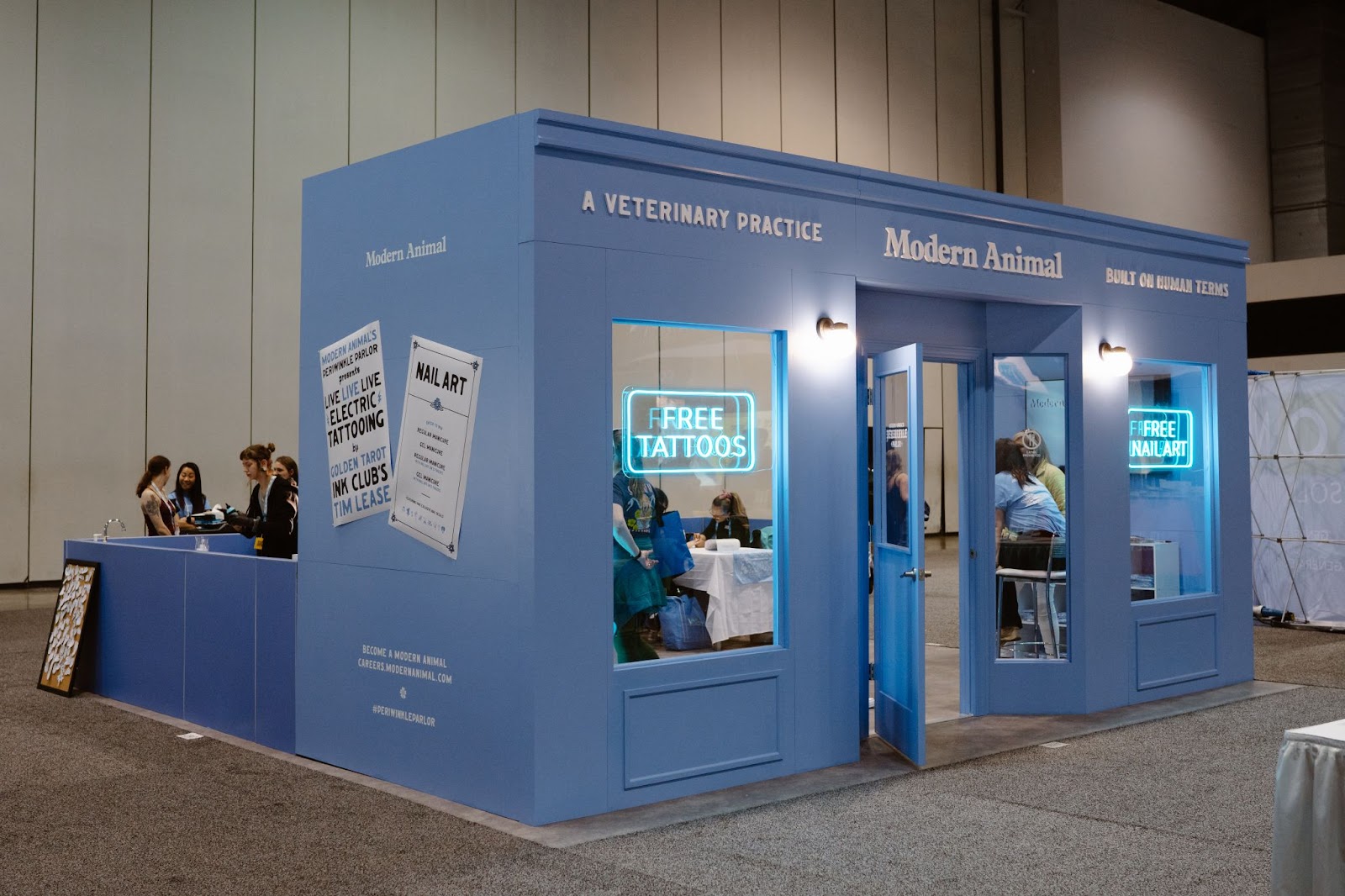
The time to do it! Veterinary teams are stretched thin, overwhelmed by workload and stress which often leaves no time for outside of work activities, team building, or merely having lunch together. It’s the leadership task to continuously spot and remove inefficiencies, improve workflows, and break silos to achieve more predictability during the day.
One way we are solving this problem is by organizing hospital schedules to make sure lunches and breaks are put into the schedule and bring small teams together. If DVMs and support staff have lunch at the same time, they are more likely to take the time they deserve, bond, and no one would feel they left the work behind for someone else.
3. Personalized Team Development
Each month in the US, 3 to 4.5 million employees quit their job according to the Bureau of Labor Statistics.
One survey found 94% would stay at their current employer if they invested in their long-term learning.

In vet med, we’re all very familiar with CE, and most employers give a CE stipend every year for their veterinarians and technicians.
But, how much are you actually encouraging your team to use it? Are you giving them PTO? Are you helping pay for their travel and accommodations (like Fen Vet)?
To dig deeper into this topic, we tapped Christy Schwartz, Executive Director, Virginia Veterinary Specialists.
How do you empower your team to grow in their role?
Professional development is not a one size fits all approach. Part of professional development is having conversations that are customized and create an individualized approach.
These conversations need to take as long as they need to be and have with intent. The seed has to be planted and watered, tended to and spoken with words of encouragement.
Management is not always going to be the appropriate person to provide that development, many times management will be just the conduit for the employee to connect with others that are more appropriate. Making sure the lines of communication are open and honest are essential parts of this, and that also means recognizing that growth of an employee may also mean they leave the organization.
Management should not prevent or hinder growth because of that fear.
What do you think is missing in typical CE programs?
Re-thinking performance reviews is the easiest and quickest way to add and track development. Adding a simple professional/personal development goal is a great starting point.
Additionally, part of what is missing currently in developmental programs is a vision. Many in the industry have been in vet med for a long time, and creativity has been muted for sake of selfishness and historical context.
“We have done it this way for years and nothing is wrong.”
“If it ain't broke don't fix it.”
Creating or supporting mentorships, encouraging CE that is not all clinical focused, encouraging use of memberships to groups that is not all clinical focused is a great way to connect staff with people that are in the same industry but doing different things.
What are some resources/organizations that can help?
So, if you’re looking for CE or programs that are outside the traditional medical CE, here are some organizations doing some awesome work in our industry:
Mentorship
MentorVet
MentorVet is a veterinary mentorship and professional development program for early-career veterinarians. We strive to promote veterinary well-being by creating a holistic support network to support veterinarians in the transition to practice. (They’re also launching a MentorVetTech program soon!)
Learn more about MentorVet here
Pawsibilities
Pawsibilities Vet Med is a 501(c)(3) nonprofit organization that proactively increases all forms of diversity within the veterinary profession through mentorship, professional development and resources to all intersecting identities including but not limited to ability, ethnicity, gender identity, non-traditional paths, race, sexual orientation, socioeconomic background, religion, and veteran status.
Learn more about Pawsibilities here
Wellness
Empowering Veterinary Teams
EVT provides RACE-certified, comprehensive, multi-disciplinary veterinary training and content to veterinary practices. The topics range from leadership training, clinical training, & non-clinical, soft skills.
Flourish Veterinary Consulting
Flourish works to promote self-sustaining, flourishing work environments one hospital at a time. They do this by increasing the well-being of individuals, teams, and hospitals through the use of positive psychology and other evidence-based tools. Flourish has consulting, workshops, and coaching packages available.
Learn more about Flourish here
Get MotiVETed! Veterinary Wellbeing Solutions
Get MotiVETed! offers courses through their online platform Get MotiVETed University including their Veterinary Burnout P.R.E.P Certification Program, Exploratory Podcast, and RACE-approved courses which are on-demand and self-paced.
Learn more about Get MotiVETed! here
Diversity, Equity, Inclusion, & Belonging
blendvet
blendvet trains & certifies veterinary teams in DEI through self-paced modules, hands-on workshops, and facilitated discussions. They cultivate a thriving hospital culture of belonging, build trusting relationships within diverse communities, and empower teams to increase the pipeline of underrepresented minorities (URMs) within veterinary medicine.
Learn more about blendvet here
Affinity Organizations
There are so many to choose from for all identities of people in vet med.
Here’s a non-exhaustive list:
- PrideVMC
- Black DVM Network
- LatinxVMA
- Multicultural VMA
- Women’s Veterinary Leadership Development Initiative (WVLDI)
- Association of Asian Veterinary Medical Professionals (AAVMP)
- American Association of Veterinarians of Indian Origin
- National Association of Black Veterinarians
- Native American Veterinary Association
- Veterinarians as One Inclusive Community for Empowerment (VOICE)
Start being proactive with your retention efforts.
Poor retention doesn’t just hit your bottom line — it affects your culture, team satisfaction, and client experience.
So, it’s time to stop being reactive with retention and only thinking about it after a team member leaves.
We can and should be proactive, and making sure we’re creating awesome experiences for our team. ❤️








